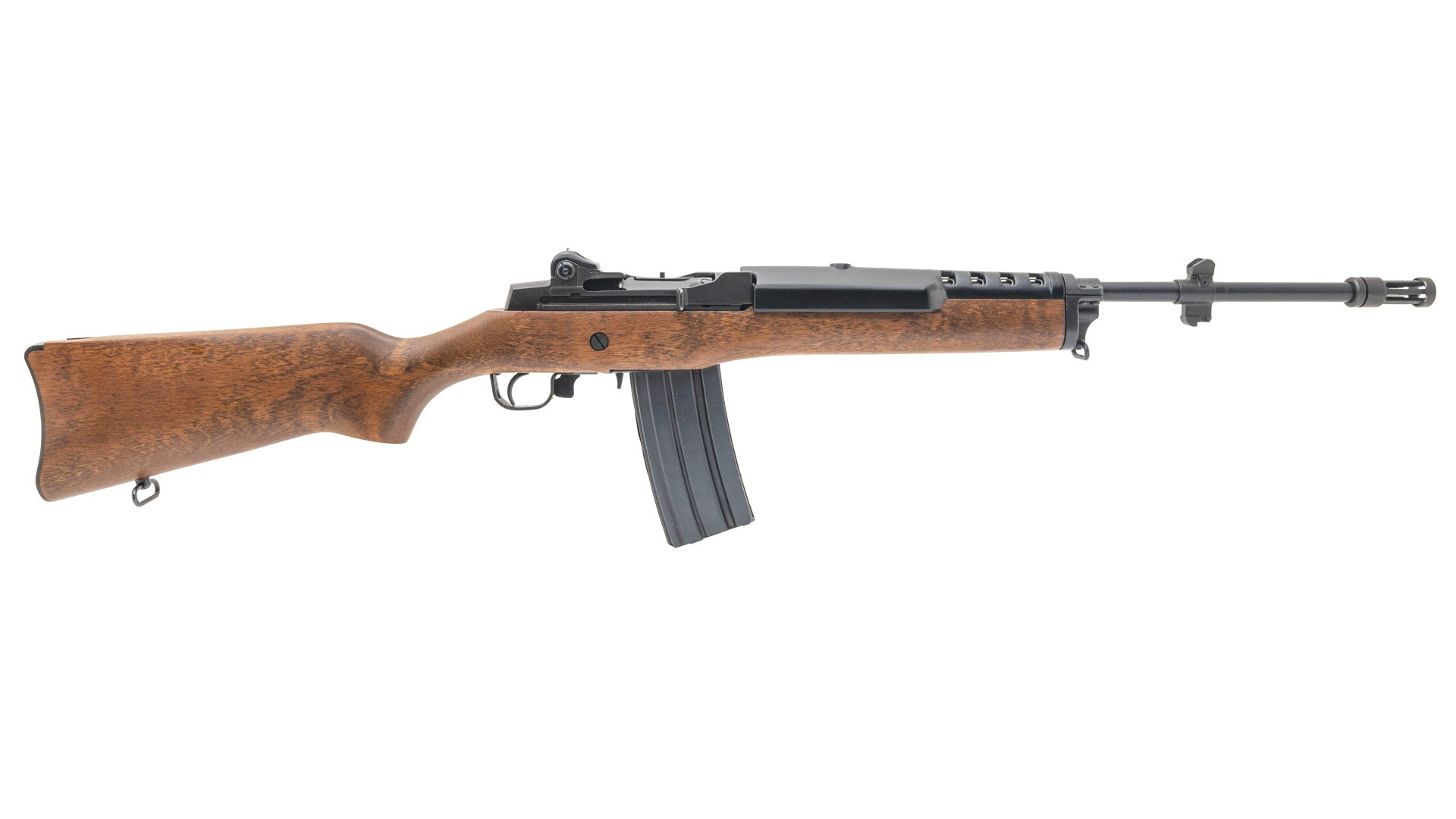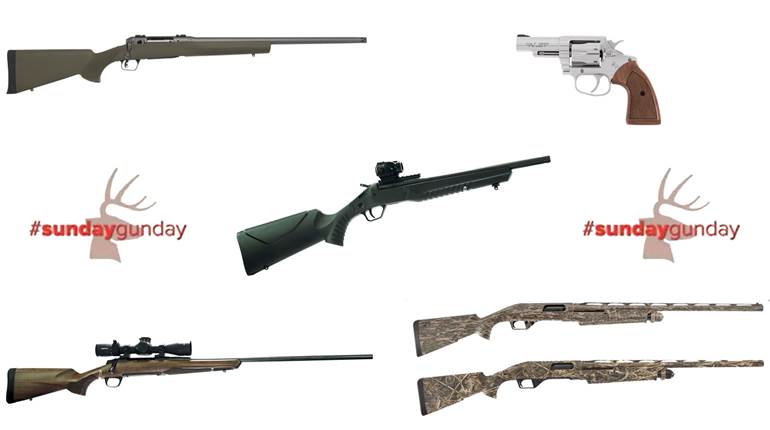
As we observe the 80th anniversary of D-Day, we do so through a distorted lens. After eight decades, the historical memory of June 6, 1944, has become so crowded with exaggerations and mythology that sometimes it feels like we hardly know the real story at all. While a few historians inadvertently contributed to the establishment of some of these myths, the big culprit has been the entertainment industry.
 “Taxis to Hell–and Back–Into the Jaws of Death” is the title of this well-known photograph taken by U.S. Coast Guard Chief Photographer’s Mate Robert Sargent on June 6, 1944, little more than an hour after the start of the D-Day invasion at the beaches at Normandy, France. It captures the U.S. Army’s 1st Infantry Division disembarking from an LCVP, or Higgins boat, and wading through waist-deep water toward the “Easy Red” sector of Omaha Beach. The original caption reads: “American invaders spring from the ramp of a Coast Guard-manned landing barge to wade those last perilous yards to the beach of Normandy. Enemy fire will cut some of them down. Their ‘taxi’ will pull itself off the sands and dash back to a Coast Guard manned transport for more passengers.” Those trips to and from the U.S.S. Samuel Chase would prove to be perilous, as it lost six landing craft that day. Design by David Labrozzi; photo by Chief Photographer’s Mate Robert F. Sargent.
“Taxis to Hell–and Back–Into the Jaws of Death” is the title of this well-known photograph taken by U.S. Coast Guard Chief Photographer’s Mate Robert Sargent on June 6, 1944, little more than an hour after the start of the D-Day invasion at the beaches at Normandy, France. It captures the U.S. Army’s 1st Infantry Division disembarking from an LCVP, or Higgins boat, and wading through waist-deep water toward the “Easy Red” sector of Omaha Beach. The original caption reads: “American invaders spring from the ramp of a Coast Guard-manned landing barge to wade those last perilous yards to the beach of Normandy. Enemy fire will cut some of them down. Their ‘taxi’ will pull itself off the sands and dash back to a Coast Guard manned transport for more passengers.” Those trips to and from the U.S.S. Samuel Chase would prove to be perilous, as it lost six landing craft that day. Design by David Labrozzi; photo by Chief Photographer’s Mate Robert F. Sargent.
Thanks to movies and video games, the way we remember D-Day has taken a detour into make-believe, and that is a big problem because the entertainment industry reaches far more people than any scholarly publication ever has or ever will. This mythologization of the narrative has even laid its hands on the subject of the guns of D-Day. The average motion picture or video game dealing with the Normandy invasion typically only features the “big six:” the M1 Garand; the M1 carbine; the Thompson submachine gun; the MP40 submachine gun; the Kar98k Mauser; and the MG42. But a broad diversity of different firearms fought that battle, and they came from more than just the United States, England and Germany. Russian, Polish, Austrian, Belgian and French guns were there, too, but you would never guess that based on what you see in the video games and the movies that bias the “big six” and forget everything else.
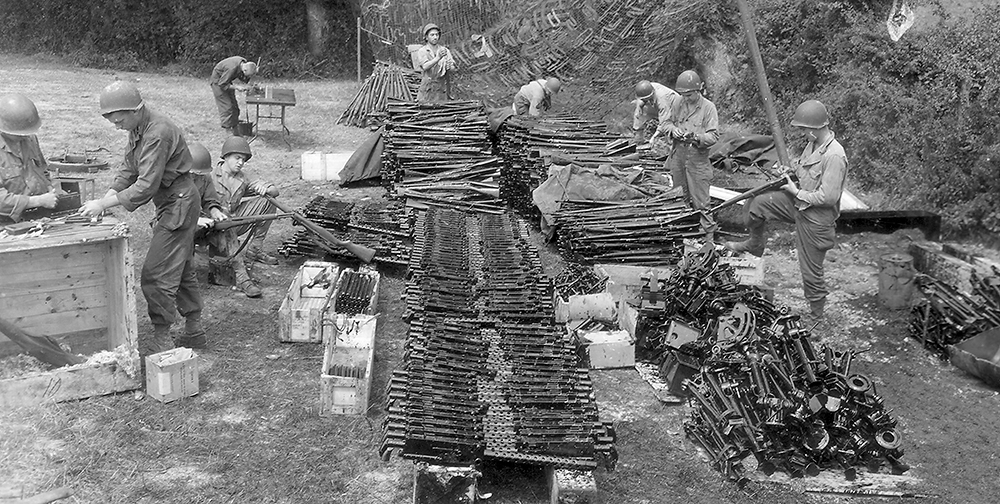
One of the Army’s most important types of supporting units, an ordnance maintenance and repair company, is seen working in a hedgerow-enclosed Norman field on July 18, 1944, to keep the guns running throughout the intense demands of combat. Among the more striking features of this image are the 116 M1919A4 machine guns lined up for servicing and the virtual mountains of M1903 rifles piled in front of the camouflage net in the background. National Archives and Records Administration/U.S. Army Signal Corps photo.
Published historians have gotten the guns wrong, too, sometimes unintentionally repeating inaccuracies that they were unaware of. When such misunderstandings merge with the bias toward the “big six,” we end up with not just an incomplete picture of what guns were used, but also a distorted one. There is, however, one very dependable source that can fill in that incomplete picture, and it is a source that never misremembers and never lies: photography. A close examination of the photos and footage that captured D-Day on film will reveal that it took much more than just the “big six” to arm everyone.
These images teach us important lessons about national mobilization and industrial production, and they also admonish us not to take the movies and games at face value. The entertainment industry is not source material, and when it becomes that, the cost can be measured by the many deep misapprehensions that will inevitably follow the story from one big anniversary to the next. Nevertheless, we will always have the photography to set the record straight and show us what the troops actually used to fight one of the most important battles of the Second World War.
 A military policeman carefully cleans his war trophy near the village of Étienville: a Gew.41(W) semi-automatic rifle. Although uncommon in Normandy, this image proves that the Gew.41(W) was there. National Archives and Records Administration/U.S. Army Signal Corps photo.
A military policeman carefully cleans his war trophy near the village of Étienville: a Gew.41(W) semi-automatic rifle. Although uncommon in Normandy, this image proves that the Gew.41(W) was there. National Archives and Records Administration/U.S. Army Signal Corps photo.
June 6, 1944, 12:01 a.m.
Inside a C-47 Skytrain transport droning across the English Channel toward France, T-4 Reuben A. Weiner was loaded down with different equipment than the men around him. They carried rifles, carbines, submachine guns and ammunition, while Weiner carried cameras. Paratroopers from the 508th Parachute Infantry, 82nd Airborne Division surrounded him on the C-47, but Weiner was from another unit: the 165th Signal Photographic Company. He was an Army photographer who had volunteered to jump into Normandy with the 82nd to document the fighting that would take place there.
The Public Relations Division of the Supreme Headquarters of the Allied Expeditionary Force planned to include Signal Corps photographers such as Weiner from the start, but most of them would come ashore with the invasion’s seaborne echelon. In the build-up to June 6, though, the Public Relations Division recognized that the 82nd Airborne would not be well-covered by photography during the critical opening phase of the invasion unless photographers jumped with the division, so a call went out for volunteers, and Weiner stepped forward. After completing an accelerated parachute-qualification course, he was assigned to jump with the 508th.
Three other photographers from the 165th Signal Photographic Company were assigned to other regiments in the 82nd and, together, these men would record on film what the division would experience on D-Day. Since they would be dropped behind the beachhead alongside the paratroopers, each of the four carried an M1911A1 .45 ACP pistol in addition to their photography equipment.

Technician Fourth Grade Reuben Weiner of the 165th Signal Photographic Company photographed Headquarters Company, 508th Parachute Infantry Regiment troopers as they took a rest break in front of the house at 3 Rue de la Fontaine in Ravenoville. Pictured are: Capt. Kenneth L. Johnson, Capt. Robert Abraham, S/Sgt. Morgan, PFC Luther Marney Tillery, PFC Joel R. Lander, Pvt. John G. McCall, PFC James R. Kumler and T-5 MacLeod. National Archives and Records Administration/U.S. Army Signal Corps photo.
Although he did not know it as he approached the French coast that night, only Weiner would get anything on film. When he finally jumped shortly after 2 a.m., Weiner came down safely, but he was 5 miles northeast of the drop zone. His cameras survived the jump with no damage, but that was not the case for the other three 165th photographers, all of whom landed in the flooded area of the Merderet River. Because of this, their cameras were either ruined by water or lost in the pre-dawn darkness.
Weiner, though, quickly assembled with a stick of troopers from Headquarters Company, 508th and, once the sun rose a few hours later, he went to work. The men were supposed to assemble on Drop Zone N just to the northwest of the town of Ste. Mère Église, so as soon as they collected their bearings, they began moving in that direction. This soon brought them into the village of St. Marcouf, where they encountered curious French civilians for the first time. Technician Fourth Grade Weiner captured several still photographs as well as some motion picture footage as this happened. His photos and footage show not only the interactions between the liberated and their liberators, but also just how well-armed American paratroopers were on D-Day.
Unsurprisingly, the M1 Garand and the M1A1 carbine can be seen, as well as an M1A1 Thompson submachine gun. That afternoon, Weiner photographed the same men taking a break in the village of Ravenoville, and he then spent his first night in France at the Marmion Farm four miles northeast of Ste. Mère Église. There, a group of 101st Airborne Division paratroopers had assembled after missing their drop zones during the night drop. The next morning, Weiner went back to work and took what might be his most famous photograph. It depicts 10 paratroopers from the 502nd and 506th Parachute Infantry Regiments, and they are heavily armed with M1 rifles, grenades and even a machete. Soon thereafter, he captured the moment that an M1919A4 light machine gun section from the 4th Infantry Division reached the farm in a photograph that documents one of the many linkups of airborne and seaborne echelons in the Utah Beach sector that took place that day.

Just off Utah Beach on June 8, 1944, an LCVP carries a group of glider pilots out to the fleet so that they can be returned to England. The most noticeable items identifying these men as glider aircrew are the Army Air Forces wings on the left collar of two of the men’s shirts and the AAF patch on the left shoulder of the M1941 Field Jacket being worn by the man with the binocular case strapped around his neck at right. Of particular interest are the two souvenir rifles leaning against the LCVP’s starboard gunwale just behind the pulley mechanism for the bow ramp—one is a German Kar98k Mauser carbine, and the other is a Soviet SVT-40 Tokarev semi-automatic rifle. National Archives and Records Administration/U.S. Army Signal Corps photos.
The images that Reuben Weiner collected during the first 30 hours leave us with a visual record of the experience of U.S. Army soldiers in combat behind Utah Beach during the opening phase of the Normandy invasion—a record that we otherwise would not have. He volunteered for the U.S. Army 600 days prior and then volunteered again to be an airborne photographer on D-Day; because of that, he was able to record what our fighting men wore and the guns they carried.
Soon other military photographers, as well as accredited journalists from the press pool, would come ashore on nearby Utah Beach as a part of the seaborne echelon, and they, too, would photograph what was happening in the hedgerows just inland from the beachhead, but they would be photographing mainly the aftermath of the battle. While their photos and footage would also provide a priceless glimpse into the visual dimension of D-Day, they could not and did not cover everything.
This meant that, for the most part, we are left only with images showing what the battlefield looked like after the last shot was fired and, unfortunately, after the guns had been policed up. Because of this, there is a bit of a vacuum—an absence of photographic record to tell us which guns did that fighting. With the passage of decades, the absence of a photographic record has led to assumptions being made about the guns and, more often than not, only the “big six” were thought to have been there. But when the student of small arms takes a closer look at the photographic record, some interesting firearms show up.
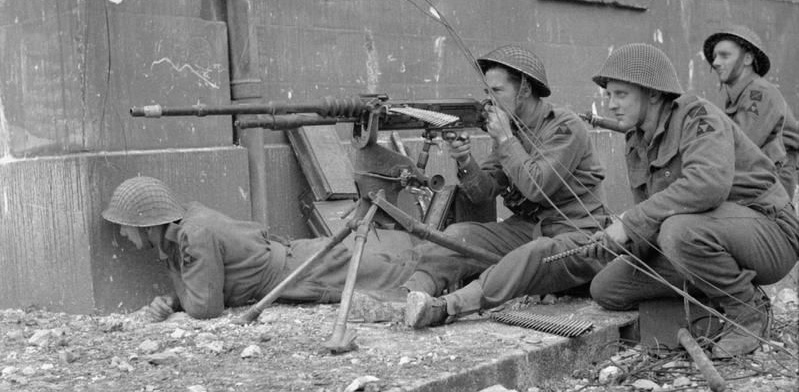
Troops from the British 3rd Infantry Division are seen here using a Hotchkiss Model 1914 machine gun during the battle for Caen. Photo from the collections of the Imperial War Museums.
On June 7, a photograph was taken showing a pair of 82nd Airborne Division paratroopers chatting with men from the 90th Infantry Division just south of the Merderet River bridge at Chef du Pont. In the photo, one of the paratroopers can be seen with a Browning High Power tucked into his cartridge belt. The following week, LIFE magazine staff photographer Bob Landry took a photograph of Lt. Kelso C. Horne, a platoon leader with I Company, 508th Parachute Infantry Regiment. The photo shows a kneeling Lt. Horne, an NRA Life Member, armed with an M1911A1 pistol as well as a Winchester M1 Garand rifle, and the image was ultimately selected for the cover of the Aug. 14, 1944 issue of LIFE.
Shortly thereafter, a LIFE staff photographer named Ralph Morse took a photo in the nearby village of Étienville showing a military policeman carefully cleaning his war trophy: a Gew.41(W) semi-automatic rifle. That MP was not the only soldier collecting rifle-shaped war trophies, though, because a U.S. Navy photographer captured two on film in a photograph taken just off Utah Beach on June 8. The image shows a group of glider pilots crowded aboard a landing craft returning to the ships offshore, and right there in the frame are two rifles: one is a German Kar98k Mauser, and the other is a Soviet SVT-40.
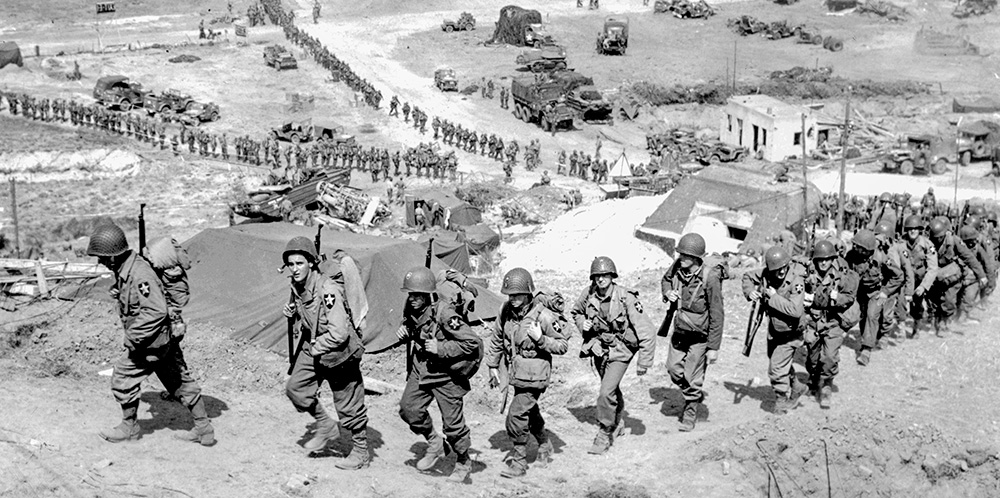
Soldiers of the 2nd Infantry Division climb the bluff behind the Wn.65 bunker in the Easy Red Sector of Omaha Beach shortly after D-Day. They are armed with a somewhat-unexpected rifle on the invasion beaches of Normandy: the .30-cal. M1903 bolt-action. National Archives and Records Administration/ U.S. Army Signal Corps photo.
Russian firearms appear in several other Normandy photos that provide proof of the fact that, by this stage of the war, the Third Reich was depending on foreign-made firearms that had been captured during previous campaigns. In one especially interesting Signal Corps image taken just inland from Omaha Beach, personnel from an ordnance maintenance and repair company inspect three foreign automatic weapons that were captured from German units on June 6: an Austrian M.7/12 Schwarzlose machine gun, a Russian PPSh-41 submachine gun and a French Hotchkiss Model 1914 machine gun.
LIFE magazine’s Bob Landry also photographed multiple Hotchkiss 1914s in Cherbourg after its surrender in late June, and an example was also photographed being fired by troops from the British 3rd Infantry Division during the Battle of Caen in July. The Hotchkiss 1914 was not the only French machine gun being used by the Germans in Normandy, though. Another LIFE magazine staff photographer named Frank Scherschel collected several photographs the week after the initial landings showing a French MAC Mle 1931 Reibel machine gun in an abandoned defensive position in the village of Grandcamp. Were it not for these images, we would remain completely unaware of the extent to which foreign guns in significant numbers armed the German military in Normandy.

Although the Third Reich produced numerous effective machine guns before and during World War II, German troops were occasionally issued captured machine guns like the Polish Ckm wz.30 seen here. A water-cooled heavy machine gun chambered for the 7.92x57 mm cartridge, the wz.30 was capable of laying down sustained bursts of fire in a way that air-cooled light machine guns simply could not. Franz Gockel of the 726th Grenadier Regiment fired this type of weapon throughout the morning on D-Day until he was wounded and subsequently evacuated for medical treatment. Bundesarchiv photo.
The plot thickens the closer you get to Omaha Beach. Thanks mainly to a certain movie that came out in 1998, a common belief has been brought into existence that imagines the German MG42 doing most of the killing there. Out of the 3,393 Americans who were killed in action on June 6, almost 1,000 were lost on Omaha, the site of the greatest loss of life among the five invasion beaches. But fragmentation from mortar fire caused most of the casualties on Omaha Beach, not small-arms fire, and it looks like the MG42 might not have even been there at all. While it was indeed a part of the Normandy campaign, there is no convincing evidence that any MG42s defended Omaha Beach at the time of the landings.
Several well-known photos from D-Day itself depict the U.S. Army 5th Corps landings there, but they were mostly taken from the decks of landing craft approaching the shore. These U.S. Navy and U.S. Coast Guard photos are among the most powerful of the entire war, but from the nearshore perspective, it is impossible to determine what machine guns were arming the various well-camouflaged fighting positions on the beach. Only a handful of photographs were taken on the beach during the morning of June 6, and those photographs likewise tell us nothing about the machine guns that were firing on the troops sheltering behind the shingle at water’s edge.
 A U.S. Army soldier inspects a Soviet DP-27 light machine gun captured in Normandy. Photo courtesy of author.
A U.S. Army soldier inspects a Soviet DP-27 light machine gun captured in Normandy. Photo courtesy of author.
Eventually, Signal Corps and press-pool photographers visited and photo-documented Omaha Beach, but they did so after the battle. By that time, the machine guns that opposed the landings on June 6 had been collected by the units responsible for cleaning up the area. Thus, the aftermath photography from Omaha Beach does not tell us anything about the types of machine guns that were there on D-Day.
So, then, what is there in the way of evidence? We do know for sure that there was one Polish CKM Wz.30 water-cooled machine gun in the Wn.62 bunker complex in the Easy Red sector because the gunner, Franz Gockel of the 726th Grenadier Regiment, described it specifically. There is also indirect photographic evidence from after the battle suggesting that the Schwarzlose, the Hotchkiss and the Degtyaryov were there as well. German records indicate that the MG34 also armed some of the resistance nests on Omaha, but there is only one photograph that was taken before the invasion showing a machine gun in a firing position on Omaha Beach, and that photograph shows an MG08 water-cooled in the Wn.66 complex.
A few personal accounts from U.S. troops who were on the beach describe being under fire from the MG42, but those accounts should be treated with a degree of skepticism, because it would be impossible to tell the difference between incoming fire from an MG42 and incoming fire from an MG34 at a range of several hundred yards. In addition to that, American troops tended to refer to every German machine gun they encountered as being an MG42, the same way that they also tended label every German artillery piece an 88 and every German tank a Tiger. Then there is the matter of Heinrich Severloh, the so-called “Beast of Omaha” who claimed to have used an MG42 to kill hundreds of soldiers from a firing position in the Wn.62 complex, but his account is no longer viewed as credible. It is noteworthy that Severloh did not publish his claims about being the “Beast of Omaha” until after a certain movie came out in 1998.
So, why is it important to figure out exactly what kinds of machine guns armed the German positions on Omaha Beach? Because in this one matter, it is possible to detect the extent to which the film industry has manipulated our perception of what happened there. Just because Steven Spielberg says there were MG42s on Omaha Beach does not actually mean that there were MG42s on Omaha Beach. There is evidence though that the MG08 and the MG34 were there alongside Russian, Austrian, Polish and French machine guns. We know this because of the photographers who left us with documentation that can’t be refuted. Were it not for them, we would be left to think that only the “big six” fought the battle, and we would be left to believe what the movies tell us.
As is so often the case, the truth behind the story is complex and complicated—and only the photographers left us with images that unquestionably prove that.



















